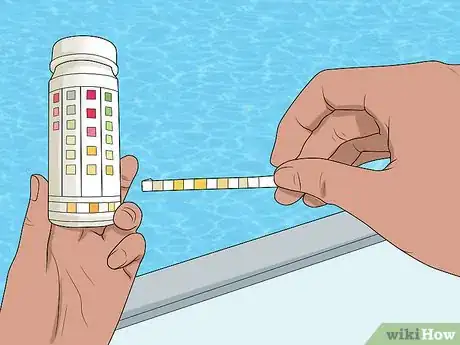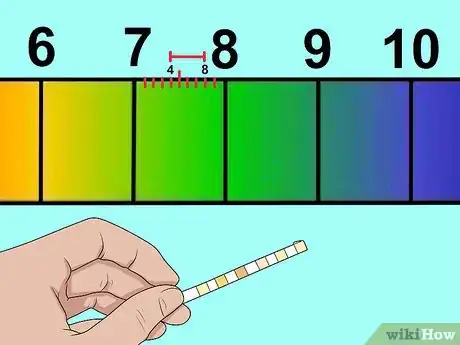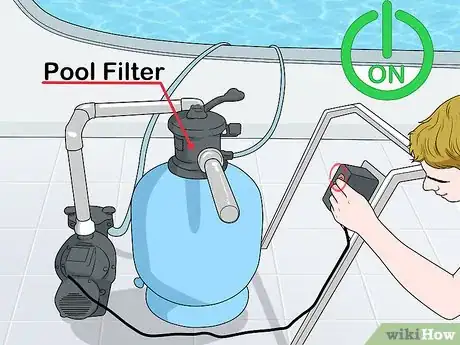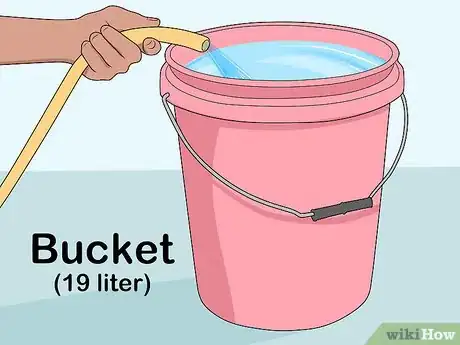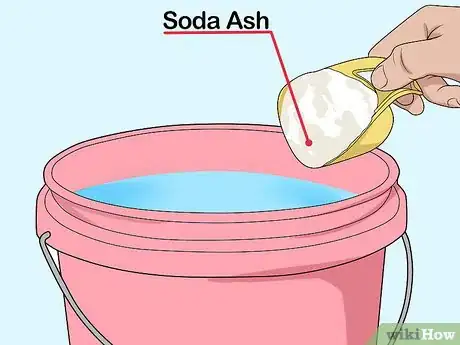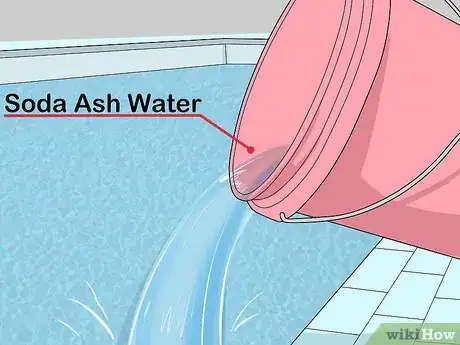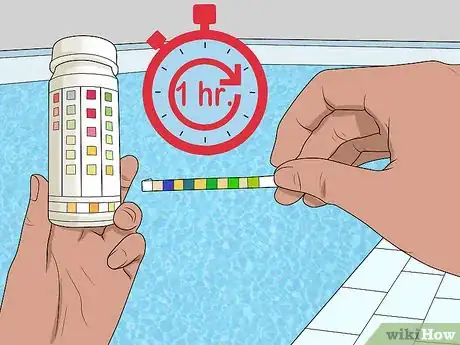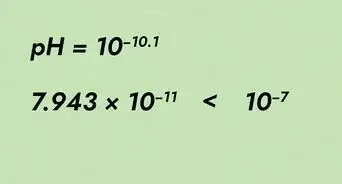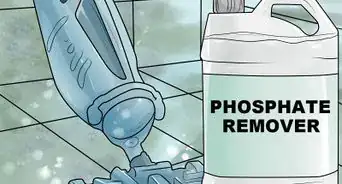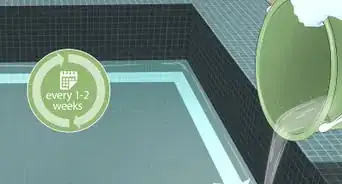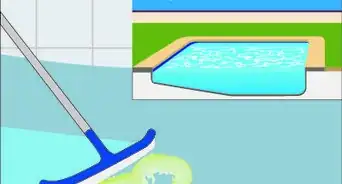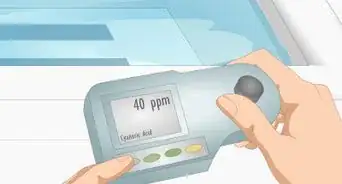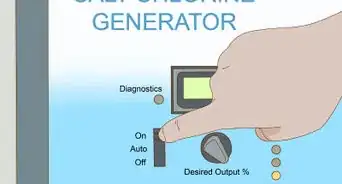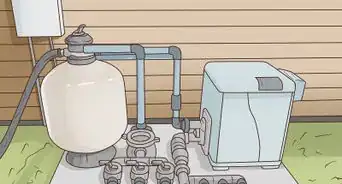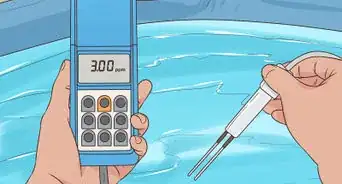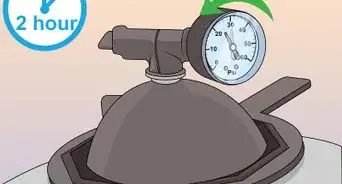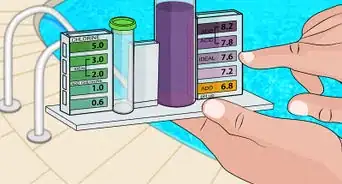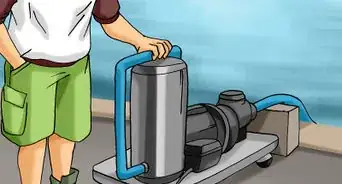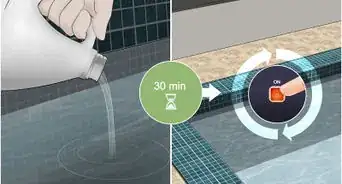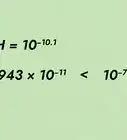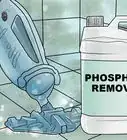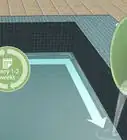This article was co-authored by wikiHow Staff. Our trained team of editors and researchers validate articles for accuracy and comprehensiveness. wikiHow's Content Management Team carefully monitors the work from our editorial staff to ensure that each article is backed by trusted research and meets our high quality standards.
wikiHow marks an article as reader-approved once it receives enough positive feedback. In this case, 91% of readers who voted found the article helpful, earning it our reader-approved status.
This article has been viewed 787,600 times.
Learn more...
Low pH levels in a pool can be caused by rainwater and other foreign particles getting into the water. Corrosion of metal accessories, burning of the nose and eyes, and itchy skin are signs of low pH levels in a pool. Regular testing and chemical treatment help maintain pH levels. Soda ash (or sodium carbonate) is the most common way to raise pH levels.
Steps
Testing Your Pool's pH
-
1Test the pool water's pH level with test strips. Get pH testing strips at your local pool store, big-box store, or order them online. Follow the product’s instructions, which are typically dipping the strip into the water and checking its color against the range listed on the product.[1]
- Some pH test kits require you to fill a small tube with pool water and add drops which change color based on the pH.
-
2Check the chemical levels one to two times per week. Record the pH level in a small notebook to track the change over time. The pH of your pool changes frequently due to many causes. This is why it's important to check often. Write the pH down in a notebook to track it as it changes over time.Advertisement
-
3Aim for a pH level of 7.4 to 7.8.. Test strips change color when exposed to water. The color corresponds to the pH level. Match the color to the package and you’ll find the current pH level. The ideal pH level for a pool is between 7.4 and 7.8. Determine how many points you need to raise the pH.
- For example, the color of your test strip might show the yellow of a banana. According to your product, this means the pH level is 7.2. You’d want to raise the pH by a minimum of .2 and a maximum of .6.
Calculating Your Soda Ash Needs
-
1Calculate the number of gallons (liters) in your pool. If you already know how many gallons (liters) your pool holds, use that number. If you need to figure out the number of gallons (liters), you’ll multiply the volume by a multiplier based on the shape of the pool. Use a measuring tape.[2]
- For a rectangular pool, the formula is length X width X average depth X 7.5. If your pool has a deep end and a shallow end, measure the depth of each, add them, and divide by two to figure out the average depth.
- For a round pool, the formula is diameter X diameter X average depth X 5.9. If part of the pool is deeper, take the shallow depth plus the deeper depth and divide the number by two.
- For abnormally shaped pools, adjust these formulas to figure the gallons (liters) in each section, or ask a pool expert for an estimate on how many gallons (liters) your pool holds.
-
2Figure out how much soda ash you need. Use about six ounces (170 g) of soda ash to raise 10,000 gallons (37854 liters) of water by .2 pH points. Start with this figure as a guide, and add more soda ash later if you need to raise the pH by more.[3]
- For example, you test the pH of the water and it shows 7.2. You want to raise it to 7.6. Your pool holds exactly 10,000 gallons (37854 liters) of water. Use 12 ounces (340 g) of soda ash for the first round.
-
3Buy the soda ash at a pool store or order it online. Soda ash may be labeled by many different manufacturer names. Look at the ingredients of the product and make sure sodium carbonate is the active ingredient. If you aren’t sure what to buy, ask an employee which products contain soda ash.
- If you don’t have a pool store near you, check at a water treatment store, hardware store, or big-box store like Walmart.
Adding Soda Ash to the Pool
-
1Leave the pool filter on while you add the soda ash. Soda ash works best when it can circulate throughout the pool. To make sure this happens, run the pool filter on its regular circulation setting. If you’ve turned the filter off to clean the pool, turn it back on.
-
2Get a five gallon (19 liter) bucket and fill it with water. You don’t want to throw the soda ash directly into the pool because it won’t mix in evenly enough. Instead, dissolve it into water and spread that into the pool. If you don't have a five gallon bucket, any bucket will work. Mix the soda ash into at least one gallon (3.8 L) of water.
- It's important to fill the bucket first and add the soda ash second.
-
3Measure the soda ash into the bucket of water. Measure out the soda ash you need based on the amounts described above. Use a basic kitchen measuring cup or a scale to measure out the amount you need. Pour the soda ash into the bucket of water.[4]
- Remember, don't put the soda ash into the bucket before the water.
-
4Pour the soda ash water around the pool. For in-ground pools, walk around the perimeter, slowly pouring the water from the bucket into the pool. For above ground pools, pour it around the edge of the pool as best you can.
- If you want, use an old plastic cup to scoop water out of the bucket and toss a cupful at a time into the pool.
-
5Check the pH of the water after one hour. Give the soda ash time to circulate throughout the pool and alter the pH of the water. After one hour, grab another test strip and dip it into the water. See if the pH is in the range you need it to be.
-
6Add more soda ash as needed. You generally don’t want to add more than one pound (454 g) total of soda ash per 10,000 gallons (37854 liters) of water. If you add more than that, the water starts to become cloudy.[5]
- If the pH isn’t where you want it to be, check it in a day or two and add more soda ash in the quantities you already figured.
Community Q&A
-
QuestionBoth my pH and my alkalinity are very low. How do I increase them?
 Community AnswerAddress alkalinity first -- add whatever adjustment based on gallon count. Then do pH. Separate by a day: alkalinity first, wait a day, pH next, wait a day. Chlorine will be eaten so fast you'll never have free chlorine but it is because the base chemical balance is not stable. Number one cause: skim and vacuum using gravity or straight to waste. Scrub the liner with a brush, row the pool of round to a tornado, vacuum over edge again, skim anything solid out. All solids must be out of the water. Add algaecide - wait four to eight hours. Then shock with chlorine -- 2 full gallons. People have trouble with balance because they think chlorine will skim and vacuum for them.
Community AnswerAddress alkalinity first -- add whatever adjustment based on gallon count. Then do pH. Separate by a day: alkalinity first, wait a day, pH next, wait a day. Chlorine will be eaten so fast you'll never have free chlorine but it is because the base chemical balance is not stable. Number one cause: skim and vacuum using gravity or straight to waste. Scrub the liner with a brush, row the pool of round to a tornado, vacuum over edge again, skim anything solid out. All solids must be out of the water. Add algaecide - wait four to eight hours. Then shock with chlorine -- 2 full gallons. People have trouble with balance because they think chlorine will skim and vacuum for them. -
QuestionCan I use baking soda to raise ph in my pool?
 Community AnswerThe simple answer is yes. Baking soda will raise the pH. However, you'll have to add much more than if you use soda ash.
Community AnswerThe simple answer is yes. Baking soda will raise the pH. However, you'll have to add much more than if you use soda ash. -
QuestionWill high alkalinity cause the pH to be low?
 Community AnswerNo, it should cause the pH to rise, not lower.
Community AnswerNo, it should cause the pH to rise, not lower.
References
- ↑ https://dengarden.com/swimming-pools/How-Much-Muriatic-Acid-Should-I-Add-to-a-Swimming-Pool-Understanding-pH
- ↑ http://www.inyopools.com/swimming-pool-calculations.aspx
- ↑ http://www.poolspanews.com/how-to/maintenance/soda-ash-vs-baking-soda_o
- ↑ http://www.backyardcitypools.com/Raising-pH.htm
- ↑ http://www.backyardcitypools.com/Raising-pH.htm
About This Article
To raise the pH of your pool, fill a 5 gallon bucket with water. Then, add 6 ounces of soda ash to the bucket for every 10,000 gallons of water in the pool. Pour that mixture around the pool’s perimeter while the filter is running so it mixes evenly. After an hour, check the pools pH. It should have gone up by 0.2 points. If you need it to be higher, repeat that process until you get the desired pH. For tips on testing your pool’s pH and chemical levels, scroll down . . .
